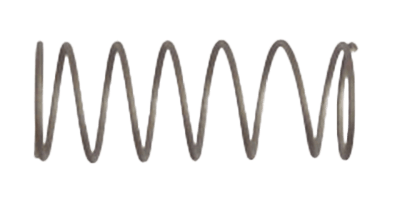What Is a Compression Spring?

A compression spring, also known as a compression coil spring, is used to absorb shock or support weight by utilizing the reaction force of a compressed spring. It’s the most common type of spring, typically cylindrical, but comes in various forms depending on its application and location. For instance, the spring inside a ballpoint pen, which helps return the pen tip, is a type of compression spring.
Characteristics of Compression Springs
Compression springs are primarily divided into “equal pitch coil springs” and “unequal pitch coil springs,” chosen based on load requirements and function.
1. Equal Pitch Coil Spring
Equal-pitch coil springs are perfectly cylindrical and exhibit a linear relationship between load and deflection. This linearity simplifies design and mathematical modeling. However, actual springs may differ from calculated values, particularly below 30% and above 70% of total deflection. This variance is due to end adhesion during compression, which slightly alters the effective number of coils.
Uses of Equal Pitch Coil Springs
These springs are used in applications such as gas-regulating valves, automobile suspensions, motorcycle clutches, retractable pens, spring beds, suitcase locks, and computer keyboards.
2. Unequal Pitch Coil Spring
Unequal pitch coil springs, varying in shape, exhibit a non-linear load-deflection relationship.
Types of Unequal Pitch Coil Springs
- Conical Coil Spring: This spring type, entirely conical, avoids coil interference during compression.
- Slack Coil Spring: Shaped like a large “slack,” used for space reduction at the ends.
- Tapered Coil Spring: A “pinched” shape that helps avoid central interference when compressed.
Uses of Unequal Pitch Coil Springs
Used in various applications, these springs are typically conical or barrel-shaped and found in battery case contact springs, foot switches, cock valves, space-saving springs, coffee filter handles, and in dampers for car suspensions and bridges.
Other Compression Springs
Beyond “equal pitch coil springs” and “unequal pitch coil springs,” there are numerous custom compression coil spring designs, each tailored for specific applications. The default winding direction is right-hand unless otherwise specified.
Other Information on Compression Springs
1. Selection of Compression Springs
When selecting a compression coil spring, factors such as spring constant, free length, and outside diameter are critical. The operational range is from the free length (no load) to the maximum allowable compression length. Proper installation often involves securing the springs at both ends with specific components, like spring washers.
2. Stress Design of Compression Coil Springs
Typically used under static load conditions, these springs should be selected so that their stress remains within the elastic limit of the material. It’s recommended to use springs where the maximum stress is below 80% of the material’s specified allowable torsional stress.